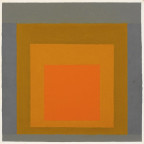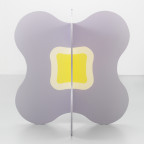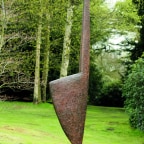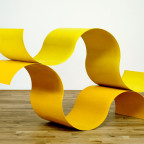Biography
Waddington Custot is pleased to present 'The Shape of Colour'; a group exhibition that explores the interplay between colour and form in artworks from the 1950s to today. The exhibition includes sculptural paintings and painterly sculptures by Josef Albers, David Annesley, Paul Feeley, Sheila Hicks, Vanessa Jackson, Sean Shanahan, William Turnbull and Fabienne Verdier. These artists use colour to create spatial illusion and collapse the traditional distinction between two and three dimensions. 'The Shape of Colour' is about liminality: tertiary spaces where form, shape and colour converge to transform perception.
British painter Vanessa Jackson's (b.1953) paintings of dancing, geometric oblongs and ovals in strong, discordant colours create illusory depth. Jackson's paintings are constructively misleading, creating optical riddles that make it hard to decipher what constitutes foreground and background. Appearing to toggle back and forth, the artwork ultimately takes place in the mind of the viewer.
Irish artist Sean Shanahan (b.1960) similarly uses colour and form to create optical illusions. Comprised of bevelled MDF rhombuses displayed in succession, they appear to slope and shift – an effect their analogous colours intensifies. Upon closer inspection, works such as 'Air Choir' (2024-25) are entirely flat, playing with our perception.
The painted metal sculptures of David Annesley (b.1936) extend the ideas of the Color Field painters, transforming flat planes of colour into drawings in space. When viewed head-on, his sculptures appear as linear compositions, yet from an oblique perspective the interplay of contour and light on the painted surfaces transforms their hues into 'imaginary colours'. Here, surface, composition and palette have a radical effect on our understanding of the work.
Known as the 'father of colour theory', Josef Albers' (1888-1976) long-running series Homage to the Square (1950-1976) likewise capitalises on optical relativity. Each painting is a precisely ordered square composition, consistently replicated with varying colour combinations designed to evoke specific visual effects. The artwork 'Homage to the Square: 'Study to in white setting'' (1959) demonstrates how colours interact and change in relation to each other, showing that colour is not static but changes constantly and relatively.
Paul Feeley's (1910-1966) work manifests in vibrantly coloured palettes, engaging with seriality and repetition. The paintings 'Untitled' (1958) and 'Untitled (February 7)' (1962) are characteristic examples of his iconic lozenge-shaped compositions in which the central motif bursts up against the rectangular seams of the canvas. Engaging with Clement Greenberg's theories on the 'integrity of the picture plane', Feeley's raises questions about the limits of flat, pictorial space and the potential for expansion into three-dimensions. This was realised later in the artist's career, such as in the artwork 'El 5' (1965), a wooden, sculptural iteration of his established motifs.
Taking the form of an irregular pentagonal flag, with flat, striped bands, ‘Added Touch’ (1975) by Kenneth Noland (1924–2010) is an example of the fluidity between painting and sculpture, flatness and form, and the decisive moment between the two. In the 1960s, critic Frances Colpitt termed the shaped canvas as ‘the dominant form of abstract painting’ and as ‘evidence of the desire of painters to move into real space’. Noland’s work is indicative of this mode.
The painted steel sculptures of Scottish artist William Turnbull(1922-2010) are monochromatic and irregular forms. Painted in flat blue ['Duct', (1966)] and white ['Echo' (1966)] their solidity makes colour itself three-dimensional, adding weight and volume to hue. Throughout his career, Turnbull engaged with both painting and sculpture interchangeably; when encountering problems in sculpture, he would turn to painting to resolve concerns on a two-dimensional surface.
Where many works in the exhibition focus on surface, the approach of Sheila Hicks' (b.1934) is - by contrast - in the tactile properties of her material. Moving away from rigid geometry, the wool and threads Hicks wraps, piles and weaves have solid colour running through them. In 'Cordes Sauvages' (2011) and 'Trésors des Nomades' (2014), the artworks' layered forms reveal the colour running through them. The effect is therefore not illusory, but in fact, hidden.
Conceived as a conceptual continuation of Waddington Custot's 2019 exhibition 'Colour Is', which examined various artistic explorations of colour throughout the twentieth century, 'The Shape of Colour' situates colour within broader considerations of form and spatial perception, demonstrating the power of shape and palette to radically transform our experience of a work of art. Ultimately, the artworks in the exhibition underscore the importance of perspective, and questions the limits of an artwork.
-
 David Annesley, Lift Going Up, Lift Going Down, 2019
painted aluminium
86 1/4 x 86 1/4 x 24 1/2 in
219 x 219 x 62 cm
%3Cdiv%20class%3D%22artist%22%3E%3Cspan%20class%3D%22artist%22%3E%3Cstrong%3EDavid%20Annesley%3C/strong%3E%3C/span%3E%3C/div%3E%0D%3Cdiv%20class%3D%22title%22%3E%3Cem%3ELift%20Going%20Up%2C%20Lift%20Going%20Down%3C/em%3E%2C%202019%3C/div%3E%0D%3Cdiv%20class%3D%22medium%22%3Epainted%20aluminium%3C/div%3E%0D%3Cdiv%20class%3D%22dimensions%22%3E86%201/4%20x%2086%201/4%20x%2024%201/2%20in%3Cbr%20/%3E%0A219%20x%20219%20x%2062%20cm%3C/div%3E%0D%3Cdiv%20class%3D%22edition_details%22%3Efrom%20an%20edition%20of%203%3C/div%3E
David Annesley, Lift Going Up, Lift Going Down, 2019
painted aluminium
86 1/4 x 86 1/4 x 24 1/2 in
219 x 219 x 62 cm
%3Cdiv%20class%3D%22artist%22%3E%3Cspan%20class%3D%22artist%22%3E%3Cstrong%3EDavid%20Annesley%3C/strong%3E%3C/span%3E%3C/div%3E%0D%3Cdiv%20class%3D%22title%22%3E%3Cem%3ELift%20Going%20Up%2C%20Lift%20Going%20Down%3C/em%3E%2C%202019%3C/div%3E%0D%3Cdiv%20class%3D%22medium%22%3Epainted%20aluminium%3C/div%3E%0D%3Cdiv%20class%3D%22dimensions%22%3E86%201/4%20x%2086%201/4%20x%2024%201/2%20in%3Cbr%20/%3E%0A219%20x%20219%20x%2062%20cm%3C/div%3E%0D%3Cdiv%20class%3D%22edition_details%22%3Efrom%20an%20edition%20of%203%3C/div%3E -
 Vanessa Jackson, Cotillon, 2024
oil on canvas
84 1⁄4 × 72 in
214 × 183 cm
%3Cdiv%20class%3D%22artist%22%3E%3Cspan%20class%3D%22artist%22%3E%3Cstrong%3EVanessa%20Jackson%3C%2Fstrong%3E%3C%2Fspan%3E%3C%2Fdiv%3E%0D%3Cdiv%20class%3D%22title%22%3E%3Cem%3ECotillon%3C%2Fem%3E%2C%202024%3C%2Fdiv%3E%0D%3Cdiv%20class%3D%22medium%22%3Eoil%20on%20canvas%3Cbr%20%2F%3E%0A%3C%2Fdiv%3E%0D%3Cdiv%20class%3D%22dimensions%22%3E84%201%E2%81%844%20%C3%97%2072%20in%3Cbr%20%2F%3E%0A214%20%C3%97%20183%20cm%3C%2Fdiv%3E
Vanessa Jackson, Cotillon, 2024
oil on canvas
84 1⁄4 × 72 in
214 × 183 cm
%3Cdiv%20class%3D%22artist%22%3E%3Cspan%20class%3D%22artist%22%3E%3Cstrong%3EVanessa%20Jackson%3C%2Fstrong%3E%3C%2Fspan%3E%3C%2Fdiv%3E%0D%3Cdiv%20class%3D%22title%22%3E%3Cem%3ECotillon%3C%2Fem%3E%2C%202024%3C%2Fdiv%3E%0D%3Cdiv%20class%3D%22medium%22%3Eoil%20on%20canvas%3Cbr%20%2F%3E%0A%3C%2Fdiv%3E%0D%3Cdiv%20class%3D%22dimensions%22%3E84%201%E2%81%844%20%C3%97%2072%20in%3Cbr%20%2F%3E%0A214%20%C3%97%20183%20cm%3C%2Fdiv%3E -
 Paul Feeley, Untitled, 1962
oil-based enamel on canvas
57 1/2 x 81 1/2 in
146.1 x 207 cm
%3Cdiv%20class%3D%22artist%22%3E%3Cspan%20class%3D%22artist%22%3E%3Cstrong%3EPaul%20Feeley%3C/strong%3E%3C/span%3E%3C/div%3E%0D%3Cdiv%20class%3D%22title%22%3E%3Cem%3EUntitled%3C/em%3E%2C%201962%3C/div%3E%0D%3Cdiv%20class%3D%22medium%22%3Eoil-based%20enamel%20on%20canvas%3C/div%3E%0D%3Cdiv%20class%3D%22dimensions%22%3E57%201/2%20x%2081%201/2%20in%3Cbr%20/%3E%0A146.1%20x%20207%20cm%3C/div%3E
Paul Feeley, Untitled, 1962
oil-based enamel on canvas
57 1/2 x 81 1/2 in
146.1 x 207 cm
%3Cdiv%20class%3D%22artist%22%3E%3Cspan%20class%3D%22artist%22%3E%3Cstrong%3EPaul%20Feeley%3C/strong%3E%3C/span%3E%3C/div%3E%0D%3Cdiv%20class%3D%22title%22%3E%3Cem%3EUntitled%3C/em%3E%2C%201962%3C/div%3E%0D%3Cdiv%20class%3D%22medium%22%3Eoil-based%20enamel%20on%20canvas%3C/div%3E%0D%3Cdiv%20class%3D%22dimensions%22%3E57%201/2%20x%2081%201/2%20in%3Cbr%20/%3E%0A146.1%20x%20207%20cm%3C/div%3E -
 Sheila Hicks, Trésors des Nomades, 2014
Synthetic fibres, linen, cotton, wool
%3Cdiv%20class%3D%22artist%22%3E%3Cspan%20class%3D%22artist%22%3E%3Cstrong%3ESheila%20Hicks%3C%2Fstrong%3E%3C%2Fspan%3E%3C%2Fdiv%3E%0D%3Cdiv%20class%3D%22title%22%3E%3Cem%3ETr%C3%A9sors%20des%20Nomades%3C%2Fem%3E%2C%202014%3C%2Fdiv%3E%0D%3Cdiv%20class%3D%22medium%22%3ESynthetic%20fibres%2C%20linen%2C%20cotton%2C%20wool%3C%2Fdiv%3E
Sheila Hicks, Trésors des Nomades, 2014
Synthetic fibres, linen, cotton, wool
%3Cdiv%20class%3D%22artist%22%3E%3Cspan%20class%3D%22artist%22%3E%3Cstrong%3ESheila%20Hicks%3C%2Fstrong%3E%3C%2Fspan%3E%3C%2Fdiv%3E%0D%3Cdiv%20class%3D%22title%22%3E%3Cem%3ETr%C3%A9sors%20des%20Nomades%3C%2Fem%3E%2C%202014%3C%2Fdiv%3E%0D%3Cdiv%20class%3D%22medium%22%3ESynthetic%20fibres%2C%20linen%2C%20cotton%2C%20wool%3C%2Fdiv%3E -
 William Turnbull, Duct, 1966
grey painted Steel
46 5/8 x 20 x 20 in
118.4 x 50.8 x 50.8 cm
%3Cdiv%20class%3D%22artist%22%3E%3Cspan%20class%3D%22artist%22%3E%3Cstrong%3EWilliam%20Turnbull%3C/strong%3E%3C/span%3E%3C/div%3E%0D%3Cdiv%20class%3D%22title%22%3E%3Cem%3EDuct%3C/em%3E%2C%201966%3C/div%3E%0D%3Cdiv%20class%3D%22medium%22%3Egrey%20painted%20Steel%3C/div%3E%0D%3Cdiv%20class%3D%22dimensions%22%3E46%205/8%20x%2020%20x%2020%20in%20%3Cbr%20/%3E%0A118.4%20x%2050.8%20x%2050.8%20cm%3C/div%3E%0D%3Cdiv%20class%3D%22edition_details%22%3EAC%20number%201%20from%20an%20edition%20of%201%3C/div%3E
William Turnbull, Duct, 1966
grey painted Steel
46 5/8 x 20 x 20 in
118.4 x 50.8 x 50.8 cm
%3Cdiv%20class%3D%22artist%22%3E%3Cspan%20class%3D%22artist%22%3E%3Cstrong%3EWilliam%20Turnbull%3C/strong%3E%3C/span%3E%3C/div%3E%0D%3Cdiv%20class%3D%22title%22%3E%3Cem%3EDuct%3C/em%3E%2C%201966%3C/div%3E%0D%3Cdiv%20class%3D%22medium%22%3Egrey%20painted%20Steel%3C/div%3E%0D%3Cdiv%20class%3D%22dimensions%22%3E46%205/8%20x%2020%20x%2020%20in%20%3Cbr%20/%3E%0A118.4%20x%2050.8%20x%2050.8%20cm%3C/div%3E%0D%3Cdiv%20class%3D%22edition_details%22%3EAC%20number%201%20from%20an%20edition%20of%201%3C/div%3E















